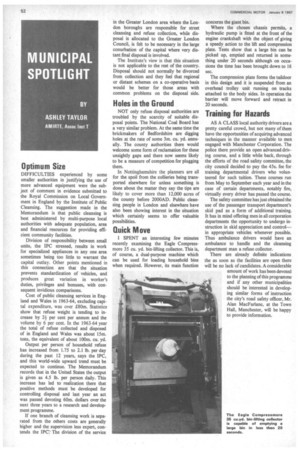MUNICIPAL SPOTLIGHT
Page 54

If you've noticed an error in this article please click here to report it so we can fix it.
ASHLEY TAYLOR
AM IRTE, Assoc Inst T
Optimum Size
DIFFICULTIES experienced by some smaller authorities in justifying the use of more advanced equipment were the subject of comment in evidence submitted to the Royal Commission on Local Government in England by the Institute of. Public Cleansing. The suggestion made in the Memorandum is that public cleansing is best administered by multi-purpose local authorities with adequate population, area and financial resources for providing efficient community facilities.
Division of responsibility between small units, the IPC stressed, results in work for specialized appliances in any one area sometimes being too little to warrant the capital outlay. Other points mentioned in this connection are that the situation prevents standardization of vehicles, and produces great variation in worker's duties, privileges and bonuses, with consequent invidious comparisons.
Cost of public cleansing services in England and Wales in 1963-64, excluding capital expenditure, was over 180m. Statistics show that refuse weight is tending to increase by 21 per cent per annum and the volume by 6 per cent. In the 1963-64 year the total of refuse collected and disposed of in England and Wales was about 15m. tons, the equivalent of about 100m. cu. yd.
Output per person of household refuse has increased from 1.75 to 2.1 lb. per day during the past 12 years, says the IPC, and this world-wide upward trend must be expected to continue. The Memorandum records that in the United States the output is given as 4.5 lb. per person daily. This increase has led to realization there that positive methods must be developed for controlling disposal and last year an act was passed devoting 60m. dollars over the next three years to a research and development programme.
If one branch of cleansing work is separated from the others costs are generally higher and the supervision less expert, contends the 'PC.' The division of the service in the Greater London area where the London boroughs are responsible for street cleansing and refuse collection, while disposal is allocated to the Greater London Council, is felt to be necessary in the large conurbation of the capital where very distant final disposal is involved.
The Institute's view is that this situation is not applicable to the rest of the country. Disposal should not normally be divorced from collection and they feel that regional or distant schemes on a co-operative basis would be better for those areas with common problems on the disposal side.
Holes in the Ground
NOT only refuse disposal authorities are troubled by the scarcity of suitable disposal points. The National Coal Board has a very similar problem. At the same time the brickmakers of Bedfordshire are digging holes at the rate of some 3m. cu. yd. annually. The county authorities there would welcome some form of reclamation for these unsightly gaps and there now seems likely to be a measure of competition for plugging them.
In Nottinghamshire the planners are all for the spoil from the collieries being transported elsewhere for unless something is done about the matter they say the tips are likely to cover more than 12,000 acres of the county before 2000AD. Public cleansing people in London and elsewhere have also been showing interest in the situation which certainly seems to offer valuable possibilities.
Quick Move
I SPENT an interesting few minutes recently examining the Eagle Compressmore 35 cu. yd. bin-lifting collector. This is, of course, a dual-purpose machine which can be used for loading household bins when required. However, its main function concerns the giant bin.
Where the chosen chassis permits, a hydraulic pump is fitted at the front of the engine crankshaft with the object of giving a speedy action to the lift and compression plate. Tests show that a large bin can be picked up, emptied and returned in something under 20 seconds although on occasions the time has been brought down to 16 sec.
The compression plate forms the taildoor in this design and it is suspended from an overhead trolley unit running on tracks attached to the body sides. In operation the barrier will move forward and retract in 20 seconds.
Training for Hazards
AS A CLASS local authority drivers are a pretty careful crowd, but not many of them have the opportunities of acquiring advanced techniques in the manner available to men engaged with Manchester Corporation. The police there provide an open advanced driving course, and a little while back, through the efforts of the road safety committee, the city council decided to pay the 45s. fee for training departmental drivers who volunteered for such tuition. These courses run from May to September each year and in the case of certain departments, notably fire, virtually every driver has passed the course.
The safety committee has just obtained the use of the passenger transport department's skid pad as a form of additional training. It has in mind offering men in all corporation departments the opportunity to undergo instruction in skid appreciation and control in appropriate vehicles whenever possible. Thus ambulance drivers would have an ambulance to handle and the cleansing department man a refuse collector.
There are already definite indications the as soon as the facilities are open there will be no lack of candidates. A considerable amount of work has been devoted to the planning of this programme and if any other municipalities should be interested in developing similar forms of instruction the city's road safety officer, Mr. Alan MacFarlane, at the Town Hall, Manchester, will be happy to provide information.












































































































